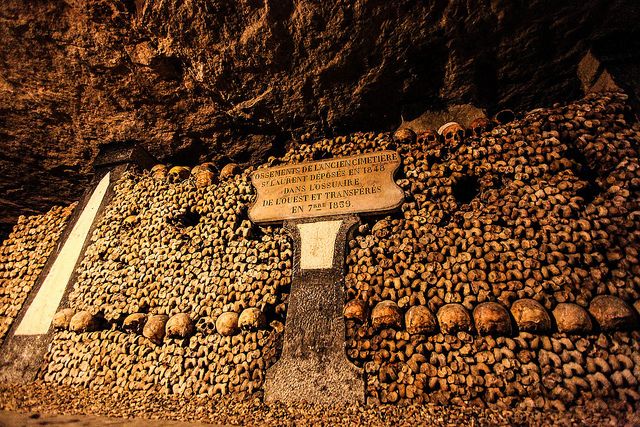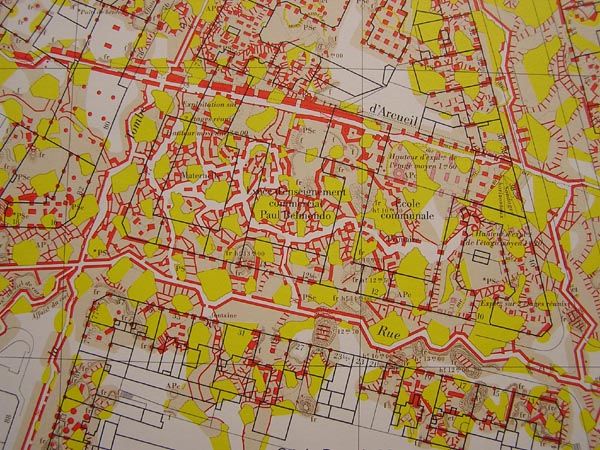Paris the City of Night

Photo of the catacombs by Frozenchipmunk
Paris, otherwise known as the city of Light could have another title too, it has one of the most extensive underground networks of tunnels of any city. You can visit some of the catacombs and this article in WSJ gives a great general overview of them and also the subculture that has grown up of cataphiles who go down (illegally) into the underground Paris. I knew a little of the story of the underground Paris of course having been there before and as a child having been down to see the skeletal catacombs myself.
But it was on my last most recent trip to Paris I picked up a book about Paris called Parisians: An Adventure History of Paris by Graham Robb, which has a chapter in it about the building of the catacombs, its an amazing story worth quickly retelling and all quotes are from Graham Robb’s Chapter concerning it.
While many people are familiar with Baron Haussmanns urban modernisation of Paris which established the wide boulevards and centerpiece Grand Avenues and monuments of the picture postcard Paris of today, most people are unfamiliar with the name of Charles-Axel Guillaumot the Architect who ‘built’ the catacombs.
In 1774 along the Rue d’Enfer a quarter mile long sinkhole opened up engulfing the houses on either side of it. Enfer being the french word for hell, the sinkhole quickly became known as the mouth of hell. In 1777 Charles-Axel Guillaumot was appointed the first inspecteur généraux des carrières, and it was clear that the reason for the sinkhole was there was a long abandoned and forgotten mine under the street, the stone of which had been used earlier for the building of Paris and then covered over. As the city expanded this long forgotten quarry now endagered the buildings above it.

The work over the next years was massive, there were three teams the Excavation team to clear the underground galleries of rubble, the Masonry Team to reinforce the roof and the Cartography team to map it all out.
the ‘Cartography’ team would create a map of the underground labyrinth on a scale of 1:216 — which meant that the map of abandoned quarries would be more detailed than any map that had ever been produced of the streets of Paris.
As the teams made their way through the abandoned quarries and mapped them out the picture gradually must have become clear and Guillaumot realised that there was not a single quarry but a whole range of them. That they didn’t occur just below the streets but often stacked one on top of each other.
The miners had dug away as much stone as they dared, leaving just enough to support the roof. Years later, other miners had found the worked-out quarries, and dug down to lower layers. The floor of each quarry then became the roof of yet another mine, so that now, instead of finding solid rock beneath the tunnel floor, Guillaumot encountered vast cavities buttressed only by a few teetering piles of stone.
Guillaumot in short discovered that not just the Rue D’Enfer but half of 18thC Paris was in danger of falling into the mouth of hell. So while the people of France were vexed about the cost of Versailles and the Royal Court, Guillaumot relatively quietly went about building on an even more massive scale.
If those galleries had been placed end to end, they would have reached the edge of the Massif Central, two hundred miles away.
part of a mapshowing paris block above with underground routes
The underground city surpassed that of the city above not just in the quality of its map. While many of the buildings in Paris were not even numbered the galleries below had their own numbering system, a lesser Architect might have just filled up the voids with rock and sand but Guillaumot
turned each cloche into a beautiful, swirling cone of stonework that might have been copied from a strange, inverted cathedral….Tunnels that had been clumsily hacked out by ignorant hands were dressed with freestone and dignified with coursed limestone walls.
Gradually these 200 miles of catacombs had been discovered mapped and reinforced and in the 1780’s when the vast rotting pits of the Parisian dead threatend the cities water supply Guillaumot had a neat proposal. In 1786 the first of many millions of corpses were moved to what is now known as the Catacombs on the left bank.
It was said that the number of skeletons that made the journey to La Tombe-Issoire was ten times greater than the living population of Paris.
Not only had Guillaumot saved Paris but he had built a shadow Paris and he had populated it. Guillaumont remained as inspector of quarries until his death in 1807, his gravestone disappeared sometime in the 1880s and, his bones were gathered up to be placed in the catacombs to join the city he’d built.

The catacombs by Doc Searls
Nowadays it is illegal to venture under the city except on official business or to visit the Catacombs the macabre section of the subterranean Paris given over as an ossiary.
Further Reading: